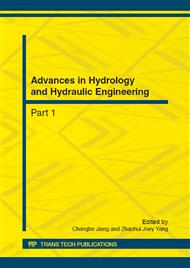p.1025
p.1030
p.1034
p.1043
p.1048
p.1057
p.1062
p.1067
p.1071
Experimental Research on Structure of Surface Orifice Flood Discharge and Energy Dissipation of Hydropower Station with Large Discharge
Abstract:
Normally, it is much complicated and difficult to design flood discharge and energy dissipation with large discharge. In this paper, twelve designed schemes of a curtain hydropower station were compared and analyzed repeatedly. It provides better reference scheme for engineering design. On weir surface and middle orifice local hydraulic model with geometry scale of 1:60, the writer tested and researched on energy dissipation capacity ,velocity and flow pattern, pressure distribution and related hydraulics problems of the curtain hydropower station discharging structure layout. Basically practicable discharging structure pattern and stilling pool pattern were put forward, through comparison and optimization of more than ten schemes. The study result showed that the surface orifice adapting proper pattern of flaring gate pier was favorable to increase the energy dissipation efficiency and shorten the length of stilling pool, but had no effect on the phenomenon of water wing hitting both sides of guide wall caused by flaring gate pier, the schemes of canceling flaring gate pier of surface orifice and adapting the declined pattern stilling pool could decrease the stilling pool floor plate velocity of under flow energy dissipation efficiently ,at the same time diminish the phenomenon of water wing hitting guide wall on both sides caused by flaring gate pier and obtain certain satisfying energy dissipation effect, moreover it had much heuristic and inspirational effect on similar projects.
Info:
Periodical:
Pages:
1048-1056
Citation:
Online since:
October 2012
Authors:
Keywords:
Price:
Сopyright:
© 2012 Trans Tech Publications Ltd. All Rights Reserved
Share:
Citation:


